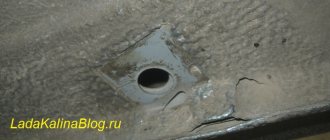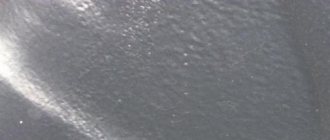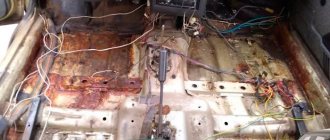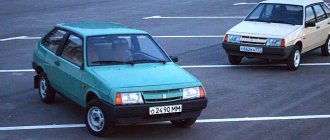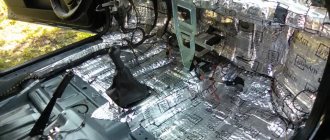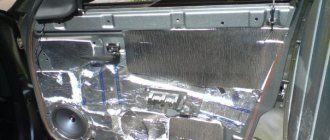Many people only care about the outer panels of the car body, forgetting about the condition of the hidden cavities and the bottom. But this is where corrosion begins first. It is important for owners of used cars to study the nuances of car anti-corrosion treatment.
Modern factory anticorrosion protection quite effectively protects the body from corrosion. But nothing lasts forever. To keep the iron in good condition, the protection needs to be updated. In addition, proper treatment will help slow down the corrosion process that has already begun for a long time.
Underground workers
In addition to the visible wear of the paintwork on the lower part of the body from constant sandblasting and road reagents, corrosion of the internal cavities is inevitable. Weld seams and rolled joints of door panels and trunk lids are also at particular risk. The problem with such areas is inadequate priming and painting, even in factory conditions.
The corrosion process is noticeably accelerated in hidden cavities. Due to poor ventilation, moisture and dirt accumulate there, mixed with road reagents, forming an electrolyte - a corrosion catalyst. And if its external manifestations are visible on the welded points of the bottom, on welds and in places where panels overlap, then everything is much worse inside.
Before applying protective coatings, the underbody and hidden cavities of an older car are washed and dried. This procedure itself significantly delays the onset of serious corrosion, since it rids the surface of aggressive electrolyte.
To protect the body, two main methods of anti-corrosion treatment are used.
Types of corrosion
There are several types of rust on the surface of a car, depending on which different methods of anti-corrosion treatment are used. According to the conditions of occurrence, the following types of rust can be distinguished:
- gas - appears on the mufflers or exhaust pipe;
- in electrolytes – located in places where moisture stagnates;
- contact rust - appears in areas where metals of different potentials come into contact;
- under friction conditions – observed in places where there is a corrosive environment;
- crevice - in cracks or gaps where water accumulates in contact with oxygen;
- biocorrosion – associated with the influence of microorganisms and their metabolic products;
- mechanical - occurs from impacts of crushed stone flying from under the wheels, tall grass, bumps on the road, which rip off the protective layer from the bottom of the car.
Canadian approach
Canada has a humid, cold climate that favors the appearance and development of corrosion. Therefore, it is Canada that is considered the legislator of the so-called ML method of body protection, although it was invented in Scandinavia.
The method involves pouring ML oils (analogues of the usual Movil and the popular Rast Stop product) into hidden cavities of the entire body through existing factory technological holes and drains. Penetrating compounds well impregnate welds and cover the internal surfaces with a film that reliably insulates from contact with air. The outside of the bottom is covered with the same materials.
The ML method is not demanding on the quality of body preparation and forgives a lot of mistakes when applying the composition. In Canada, for example, they don’t wash the bottom thoroughly, but only knock off large pieces of dirt. The ML oils used have excellent penetrating ability and saturate surfaces and seams well even in such conditions.
They can be applied over any rust - the composition includes inhibitors (chemical reaction retarders) of corrosion. But to achieve maximum effect, it is better to thoroughly rinse the bottom and its hidden cavities.
The disadvantage of ML oils is low mechanical strength. In hidden cavities they last for years, and on open surfaces they wear off quite quickly.
Chemical manufacturers also develop processing schemes for machines of specific models. They indicate factory technological holes and additional ones that are proposed to be drilled in order to fully fill all hidden cavities. In fact, servicemen rarely make holes in the body, if only because the owners are often against it. In most cases, additional holes are not so necessary for full processing. By the way, these diagrams are useful for studying the structure of a particular body, especially when a rare model arrives for processing.
SWEDISH REPLY
The abbreviation ML denotes anti-corrosion compounds for hidden cavities of the car body, as well as the treatment method. Behind these letters are two authors: the Swedish automobile association Motormannen and the ideologist of the direction, Sven Laurin. At the end of the 50s of the last century, one of the specialized companies offered car owners a new service - complete body processing using the ML method. Although this technology was first tested 20 years earlier.
Hammer soldering iron
How to learn how to putty car body parts with your own hands
- Before starting work, the repair area, which has through corrosion, should be cleaned of rust residues;
- Because solder will not stick to a rusty surface;
- The most important thing is not to be lazy, when you are too lazy to tinker, then go back to the beginning, where it is recommended to purchase a new part;
- To remove the remaining rye you will need a pointed needle file, or a piece of hacksaw blade, or a knife with a sharp blade and abrasive sandpaper;
- Use coarse sandpaper (grain P60-80) to pass through the rust spot (if not brushed), this removes the surface layer;
- Then you should pick out any rust that has already set in from the metal;
- To make the places clearly visible, you need to apply a rust converter with a brush and wait a couple of minutes;
- The rust will darken and become clearly visible on clean metal; at this stage you will need pointed objects to pick out rotten metal;
- The process is the most tedious and time-consuming;
- You should constantly apply rust converter to these areas with a brush;
- This way you wash away the rust you've already picked off and see where you need to put in extra effort;
- After the place has been cleaned, you can begin servicing it;
Attention: When the diameter of the through holes exceeds 2-3 millimeters, it will no longer be possible to fill them with solder; this method is suitable when through corrosion forms in the form of a fine mesh
- Apply soldering acid to the surface before it dries, you need to apply tin solder with a heated soldering iron over the entire cleaned surface, where there are already and may appear holes from corrosion
- For better tin solder adhesion, constantly lubricate the evaporating acid
- When the metal of the case is thick and the power of the hammer soldering iron is not enough to heat the tin, then use an industrial hair dryer or a second soldering iron
Advice: Soldering must be done in the open air or in a ventilated room (or in a room with forced exhaust), since the evaporated acid is very harmful to the respiratory tract, and its smell is not pleasant.
Repairing corrosion damage to the body cannot be done carelessly; the price of careless work is that the body will rust again and very quickly; After completing the work, check again with a light to see if there are still any through holes; After the repair area has been tinned and the corrosion areas have been soldered, the treated surfaces should be cleaned of any acid and converter that may remain; As a rule, they are washed with water or a mixture of gasoline and alcohol; In order to increase the service life of a repaired body part, it is important to properly protect it from contact with the atmosphere; Apply acid primer to the tinned area of this body part using a paint sprayer, then acrylic primer on top of it, only after that can the surface be puttied;
Important: Putty cannot be placed on top of acidic primer, so acrylic primer is used
- If suddenly, when sanding the putty, you get rubbed down to the metal, there’s nothing to worry about, just blow it with acid primer again and cover the exposed areas with acrylic;
- When completing the restoration of a rusty car body, you should definitely protect the back side of that repair area;
- The condition is mandatory! Otherwise, all the work done will go down the drain;
- There are many ways to protect against corrosion, the main thing is to block the access of moisture and air to the protected area;
- The first option is to prime the back side with acid and acrylic primers;
- The second option is to apply a layer of good sealant, mastic, or fill it with Movil;
- The choice of option will depend on the ease of access to the surface being treated;
- If you can’t get to it with a sprayer, try applying the primer with a brush, and then cover it with Movil, to be safe, or a similar product;
- Now it is clear to you how to restore a car body from rust with small holes;
old light
The second approach is European, more serious. In addition to treating hidden cavities with ML oils, hard (bitumen) protective compounds are applied to open underbody panels and wheel arches. This method is more demanding on the quality of preparatory work. It is important to thoroughly wash the open bottom panels, otherwise the bitumen compounds will quickly peel off.
The main advantage of bitumen coatings is their high mechanical strength. Various types of them, for example, compositions for liquid fender liners or for underbody panels, can protect the metal from external influences for a long time.
Bituminous coatings can be applied to rust, but with reservations. If the corrosion is superficial, just in case, the affected area is impregnated with ML oil and after that a solid composition is applied. With deeper layer-by-layer rust, impregnation with ML composition may not help. Moreover, the development of corrosion cannot be controlled, because bitumen coatings, unlike ML oils, are opaque. Therefore, in each specific case, the master assesses the degree of rust damage and the possibility of applying a bitumen coating over it.
When treating the bottom with a bitumen composition, the same restrictions apply as with ML oils. If bitumen gets into the outlet, like ML oils, it can be removed with solvents, but you will have to spend much more time and effort.
DANGEROUS SAVINGS
There are a huge number of companies on the market offering their anti-corrosion compounds. All products have comparable quality, but preference should be given to well-known players, for example: Tectyl, Noxudol, Dinitrol, Waxoyl.
Branded chemicals are not the cheapest, but they have been tested many times. This is what specialized services work with, having seen the results of using products from dubious manufacturers. Low-quality products do not protect, but kill the body. For example, left ML oils, instead of deeply impregnating surfaces and seams, creating a protective layer, act in the opposite way. They have very low fluidity, clog drains, and also form a thick membrane film, under which corrosion only accelerates. And cheap bitumen compounds have an extremely short service life. Drying quickly and cracking, they to some extent protect the body from mechanical stress, but not from corrosion.
We treat the underbody of the car against corrosion with our own hands!
Three reasons - three components of corrosion
The common myth about the “eternal body” of a favorite car turned out to be the same myth as the story about the “perpetual motion machine”. Cars, both before and now, have rusted and continue to rust. Only in each individual case, the rate of corrosion depends on a number of reasons, which I would like to talk about.
Firstly, this is the pretentious geometry of the body and technological miscalculations made during its manufacture. The blistering paint on the doorstep of a Ford is a prime example of this. The source of corrosion arose precisely in the place where the gentlemen engineers designed special holes into which the rubber lining piston is attached. The cover, of course, is a necessary thing, but through the mentioned holes moisture, dust, and dirt penetrate directly and all year round. In a word, a breeding ground for rust arises. Of course, H time will come and you will find a hole on your doorstep. And not just one.
Secondly, gentlemen sellers don’t really think about how to properly handle all these hidden “bulges and bulges”. If you can’t see it, that means there’s no problem! Often, a meager layer of anti-corrosion protection (anti-corrosion) can be found only in the most problematic and visible places. In this case, the bottom of the car and its hidden cavities remain practically without anti-corrosion protection. Therefore, the first signs of corrosion can be found on the body of a completely new car standing in the cabin! Gentlemen would at least look out the window sometimes if they are not already aware of how harsh the climate is in our country.
Thirdly, improper care of the car body during its operation. And here everything depends only on the owner of the car itself. Some of our automotive fraternity are not lazy to regularly stop by a car wash and carefully examine the car body several times a year for any rust that has appeared on it. And some people prefer not to spend money, rightly believing that the excess dirt will fall off on its own. True, along with the dirt, a fragment of a completely rusted car body may well peel off.
And there is also a factor that provokes corrosion: contact of steel parts with parts made of duralumin, rubbers and plastics made from phenolic resins.
The humidity, high concentration of saline solutions and sulfur compounds in the atmosphere of industrial cities should not be underestimated.
Oink, oink, oink - I love galvanized steel!
Today, when talking about a car body and methods of anti-corrosion treatment and protection, one cannot ignore the fact that every year in the production of cars of various brands, galvanized steel sheets are increasingly used in their construction.
The use of galvanized sheets certainly increases the corrosion resistance of a car body, but one must keep in mind that the dissociation (dissolution) of the zinc layer occurs in industrial cities at a rate of about 3–5 microns/year. Thus, with an average thickness of the zinc layer of about 15 microns in places where the coatings are damaged and factors causing corrosion are present, the zinc will completely disappear in 5 years, leaving behind an unprotected sheet of metal. In addition, it is necessary to take into account the fact that if the integrity of the zinc layer is damaged at its border with steel, conditions are created under which the corrosion process develops at double, if not triple, speed.
Anti-corrosion treatment of the car once every five years
Many motorists are of the opinion that if rust has already “registered” on the car body, then they can only courageously accept this fact, since there are no effective ways to combat it. In fact, this is not so: many modern anti-corrosion preparations can effectively cope even with the process of corrosion of a car body that has already begun.
The question “Where to go?” I must admit, it didn’t bother me, not so long ago in the area of the “Water Stadium” a post was opened for anti-corrosion treatment of cars with drugs
Swedish company Noxudol, whose product range includes two very interesting materials - Noxudol 300 and Noxudol 700.
Noxudol 300 on a paraffin-oil basis is intended for treating the underbody and wheel arches of a car, Noxudol 700 is made on an oil basis for treating hidden cavities using the ML method*.
These materials have good anti-corrosion properties, superior in degree and duration of protection with an extremely high percentage of “dry residue” content of 95% and 97%, respectively.
And their “zest” is that, unlike bitumen-based preparations, they do not contain organic solvents.
In practice, this formula of drugs results in the fact that all the anti-corrosion material remains on the treated surface. The resulting protective layer retains its plasticity, and therefore its high protective qualities, for quite a long time. This circumstance allows us to provide a guarantee for the anti-corrosion layer formed with its help for a period of 4 to 5 years, without repeated treatments during this entire period. Already with a layer thickness of 150 microns, Noxudol 300 forms a high-quality protective coating (versus 250 microns or more typical for bitumen preparations). But what is most remarkable is that these materials do not emit harmful fumes and are practically odorless.
Clean, wash, dry
So, on the appointed day and time we go to the specified address.
As they say, “a good start is half the battle,” and in this case, “a good wash is the key to successful anti-corrosion treatment.” Therefore, having driven the car into the “wash”, you have to be patient. It took more than an hour to scrub the body and properly clean the dirt from the fender liners and wheel arches; for another hour, already on the lift, the inside of the car was cleaned and dried. And only after this was everything ready to begin working directly with anti-corrosion compounds.
As is the case with any other large company that produces anti-corrosion materials for cars, the entire process of anti-corrosion treatment of a car occurs according to specially compiled technological maps. Such a map includes all stages of anti-corrosion treatment and is compiled taking into account the characteristic features of the body of each car model. Therefore, a printout with a detailed map-scheme of anti-corrosion treatment for a Ford Escort 1998. was posted in a visible place in advance.
Corrosion comes from within
All hidden cavities of the car were treated with Noxudol 700 using the ML method. The technology of the ML method is as follows: a material mixed with air is sprayed inside the cavities, forming a mist, which then condenses on the surface to be treated to form a protective film. The thickness of the film obtained in this way is usually about 50 microns. The materials that are used for this case, the so-called. ML materials are characterized by low surface tension, which determines their high penetrating ability and good moisture-displacing abilities.
The composition is fed into hidden cavities through technological holes (existing or specially drilled) using special spray nozzles; this time a nozzle was used that sprays the working mixture at a right angle.
Following the instructions of the technological map, all the hidden cavities mentioned in it were sequentially processed, which could be reached while the car was on the ground, including the cavities of the hood, front panel, trunk lid, and rear panel. Next, we processed all the box-shaped power elements indicated in the map, front side members, door pillars, longitudinal beams of the front wings. To process the internal surfaces in the car doors, additional technological holes had to be drilled. Here, perhaps, the craftsmen made the only miscalculation, since the holes were not made with a special countersink drill, which immediately flares the edges of the holes made in the metal, due to which the metal acquires the ability to resist corrosion much more effectively. But what’s done is done, especially since after finishing the door processing, special rubber plugs were inserted into the holes made, which in turn were also “spilled” with an anti-corrosion compound. Additionally, Noxudol 700 was used to treat metal sections of the front fenders, front and rear window openings, etc.
Who's lying on the bottom there?
The next stage of anti-corrosion treatment is the treatment of the car underbody and wheel arches. The car’s “belly,” which has been washed clean, generously shares the news stored up over the past year and a half, since the previous anti-corrosion treatment. At that time, the bottom of the car was “anti-corrosion” using traditional bitumen preparations, and I want to note, they were not of the poorest quality. But, frankly speaking, we didn’t like what we saw.
Externally, the coating still retained its integrity, but those areas that had already peeled off from the bottom were very easy to distinguish from those that were still tightly attached to the iron, thanks to the color difference that existed between them. Lighter areas of the coating indicated that in these places there was no air gap between the anti-corrosion layer and the car underbody, while its darker areas indicated the opposite. As a result, in such places the anticorrosive layer no longer protected the metal, but, on the contrary, “thanks to” the moisture accumulating in them, like in bags, it stimulated the corrosion process. In addition, all hidden cavities and box-shaped power elements, accessible from the bottom of the car, were completely dry inside. The concern was caused by joints and welds, where rust felt more than confident.
While the hidden cavities and box-shaped power elements were being treated with the already well-known composition Noxudol 700, a barrel with anti-corrosion mastic Noxudol 300 was being prepared (warmed up) for work, but first it was necessary to remove the darkened layer of old anti-corrosive from all areas of the bottom. It cannot be said that scraping off the mastic from the darkened areas was very troublesome: under light pressure with a metal spatula, it peeled off from the rust-touched bottom in whole stripes. According to the experts, this picture is the result of poor preparation of the car surface for anti-corrosion treatment and the wrong choice of the anti-corrosion materials themselves.
One layer is good, but two is better!
To treat “problem” areas and areas affected by rust, a two-stage (Noxudol 700 + Noxudol 300) anti-corrosion coating system was used. During this process, Noxudol 700 is first applied to the rust: penetrating deeply into the structure of the rust, it saturates its layer with corrosion inhibitors, and the thick mastic Noxudol 300 applied next forms a chemical and wear-resistant protective layer in this place. In addition, the anti-corrosion drug Noxudol 300 includes a package of additives to improve adhesion and corrosion inhibitors, and due to the absence of organic solvents in its composition, when drying, its surface is not covered with a network of micropores. Such areas, and along with them the rest of the bottom area, were treated with this drug. When working with this material, an airless application method was used; in this case, the material is sprayed through a small cross-section nozzle with high pressure, about 120 atm.
To protect wheel arches, the Noxudol product line includes a separate product, the so-called. “liquid fender liners” Noxudol Autoplaston. This preparation, made on a bitumen base and reinforced with rubber and fiberglass, is applied with a brush or spatula.
After finishing the treatment on the outside, the entire car body was covered with an anti-corrosion coating, formed due to two factors: spraying of the substance during treatment and high penetrating abilities. But we didn’t have any problems with this coating; in just ten minutes, after moistening a soft rag with Avfettning (Noxudol), the site foreman, working with four hands, completely wiped off the entire paintwork of the car and its glass from the unwanted anti-corrosion layer.
As a farewell, a small Noxudol sticker is attached to the glass, and a certificate of anti-corrosion treatment of the car is issued, which already indicates the date of the next inspection of the condition of the applied anti-corrosion layer. Well, guys, thank you for the warm welcome and see you in a year at the same place, at the same hour.
https://catalog.autodela.ru/article/view/3403
Election campaign
When using a car year-round in a large city, where roads are actively watered with reagents in winter, the first external signs of internal corrosion appear after about five years or 100,000 km. The most economical way to significantly extend the life of the body is to wash the underbody and its hidden cavities every 50,000–70,000 km. In Moscow, this service costs 2000–3000 rubles.
Ideally, it is worth supplementing the first wash of the bottom with treatment of its hidden cavities. Moreover, at the next visit, for example after 50,000 km, it is no longer necessary to rinse the internal cavities and refill them with ML oil - it “lives” there for a very long time. Such complex processing will save a decent amount. For example, for 8,000–9,000 rubles they will thoroughly wash the bottom, treat hidden cavities and apply ML oils to open panels.
This option is suitable for normal urban use. On open surfaces under such conditions, ML oils can withstand 20,000–30,000 km. And if the bottom is covered with plastic shields, the composition will last much longer. A combined approach is also possible. Unprotected and particularly susceptible to sand blasting areas are covered with a bitumen composition. An owner who wants his car to have a long life can “douse” it with ML oils every year over the old coatings.
What is used for breeding?
Depending on where the material will be applied, the proportions and density are changed. Otherwise, the composition simply will not be able to stay on the surface before it dries completely. Mastics are different, which means the products for breeding will also be different.
Most often used to dilute materials:
- Motor gasoline or kerosene.
- White Spirit.
- Gasoline "Galosh".
In most cases, low-octane gasolines are used as diluents. The polymerization process of the dissolved composition takes 24 hours after application. This is provided that the work is performed outdoors. When choosing how to dilute bitumen mastic, you should definitely remember that even low-octane gasolines are flammable liquids. Vapors from any fuel are flammable. During waterproofing work, you should not use open fire.
As for the proportions, they must correspond to the volume of the base used. If you violate them, the mixture will dry out more slowly or the fluidity of the solution will increase. As a result, adhesion will decrease or beneficial properties will be lost. In this case, the material will not have protective functions.
How can you dilute rubber-bitumen mastic? There are other materials. This is turpentine, any types of organic solvents. It is not recommended to use acetone or liquids based on it for these purposes. Some craftsmen dissolve mastic in diesel fuel. As a result, the mixture turns out to be heterogeneous. However, this solution fills all cracks and irregularities with the highest quality possible. If the mastic is liquid, it has better adhesion and good insulating properties.
The importance of anti-corrosion treatment of a car on Russian roads
Most new cars sold in the Russian Federation already have anti-corrosion treatment performed on the car assembly line. However, in the conditions of our Russian winters, it would be useful to carry out additional anti-corrosion treatment, which will increase the protection of the underbody of the car body from the strongest chemical reagents on our roads. Judging by practice, those who perform additional anti-corrosion treatment do so for good reason.
There are statistics that one layer of anti-corrosion treatment of the body effectively protects the car only for two to three years. Further anti-corrosion treatment of the body should be repeated regularly. Modern materials for anti-corrosion treatment of car bodies make this process easier and allow you to do it yourself.
Bottom painting process
Painting or anti-corrosion treatment of the underbody of a vehicle is carried out using the material selected for protection. Before applying it, you should completely and completely clean it of dust, only then can you paint this element.
If materials such as mastic and primer have been selected, it is recommended to apply them with a brush or a special device - a spray gun. The primer usually contains some amount of zinc, which greatly increases its resistance to destructive corrosion processes. These materials must be mixed very thoroughly before use. Zinc powder is added independently, but this operation is not allowed for all types and varieties of soil.
When treating the surface, zinc powder can be added independently, but this process is not permissible for all types of soil. First of all, this is necessary to completely remove any rust that has formed from the surface of the bottom.
The process of applying mastic is carried out strictly on top of the primer. Initially, it is recommended to completely degrease the surface and also thoroughly sand it.
For this purpose, white spirit is used, as well as a special abrasive no finer than grade P280. Before applying mastic, all hard-to-reach cracks present are carefully filled with a special composition, which is intended for automotive preservation. This can be cannon fat or Movil, which can effectively prevent water from penetrating into them. To continue working, you need to wait until the Movil used is completely dry. This usually takes at least 4 hours.
As for the drying process of the mastic, this process is carried out within two days. It is not recommended to allow these compositions to dry completely. It is enough to withstand 5-6 hours at room temperature for two layers.
For the highest quality application of mastic, experts recommend using two spatulas - narrow and wide. The solution must be rubbed in very carefully, not leaving any holes or irregularities unattended. Painting is carried out in stages, the composition is applied layer by layer with sufficiently strong pressure, which is required to squeeze air and moisture out of the cracks.
To achieve the maximum effect, it is necessary to apply at least 3 layers of mastic, and the thickness of each should be from 0.2 to 0.4 mm, no more and no less. Painting over mastic is done quite rarely, since the anti-gravel composition is sprayed after the last layer has completely dried.
To treat the underbody of a vehicle with your own hands, the principle of impregnating corrosion with a special composition, which is made on the basis of varnish, is used. In this case, rust binds in a special way and turns into a special composition that is a little like paint. In addition, there is a coating that is designed specifically to effectively protect various chrome parts of the vehicle. To treat the bottom, a special anticorrosive varnish is usually used, which forms a protective, shiny film on the surface of the parts. It is advisable to clean them very well before painting and treating them with a special varnish.
Preparing the car body for anti-corrosion treatment
Indeed, you can do anti-corrosion treatment of a car body with your own hands. However, before doing this, you need to prepare the car itself. The table below describes the algorithm for preparing a car for anti-corrosion treatment.
| Step | Description |
| Checking the body for rust | At the very beginning, it is necessary to visually check the entire car body, including the bottom, for the appearance of rust. If you find swelling of the paint or visual traces of rust, then this area needs to be cleaned with sandpaper. Thus, to remove all traces of rust and leave a clean metal surface. |
| Car wash | Before starting anti-corrosion treatment, it is necessary to thoroughly wash the car. This means that it will be necessary to remove dirt from all hard-to-reach places. In this case, you need to wash the car with warm water using detergents, which then rinse with plenty of water. |
| Drying the car body | After washing, the car body will need to be thoroughly dried. The outer part of the body will need to be wiped dry with rags, but the bottom will need to be dried with a hairdryer. |
| Releasing the trunk | The bottom of the trunk will also be subjected to anti-corrosion treatment. That is why it is necessary to remove all unnecessary things from the trunk, remove the carpet and the inner lining of the trunk. |
| Freeing the car interior floor | Remove all carpets and felt interior trim from the vehicle's interior. If soundproofing is installed, it will also need to be removed. The pedal assembly will need to be covered with newspaper to prevent anti-corrosion material from getting on it. |
Preparing tools
If you remove rust from the bottom of a car with your own hands, then to carry out the work you need to purchase special materials and prepare tools:
- sanding machine or sandpaper;
- putty knife;
- blowtorch;
- mastic remover;
- metal brush or roller;
- degreaser;
- anti-corrosion primer;
- rust converter;
- putty;
- latex gloves;
- paper mounting tape.
Anti-corrosion treatment of the car underbody
To treat the underbody of a car against corrosion, it is necessary to use specialized material. For this process, it is necessary to place the car on a pit and remove its wheels so that there is access to the wheel arches. After this, you can start spraying anti-corrosion material on the bottom of the car. In this case, it is worth paying special attention to the following elements: welds, fasteners, bolt connections, suspension elements, ball joints, wheel arches.
The most effective tool for applying anti-corrosion material to the underbody is an airless spray gun.
The most effective tool for applying anti-corrosion material to the underbody is an airless spray gun.
Features of material selection
To effectively protect the underbody of a car, a large number of different materials are used, more than half of which are paints. Among the various primers with an anti-corrosion effect, the following compositions can be distinguished:
- Epoxy primer, which is able to set sufficiently high adhesion parameters, and also has durability indicators;
- Lead plumbate or special red lead, which provides optimal protection against moisture and various mechanical damages;
- Special liquid, cold zinc is used, which can replace factory galvanization;
- Liquid plastic, as well as special corrosion-resistant mastics. In terms of their level of protection, they are a little like soil, but with sufficiently strong vibration they can peel off;
- Anti-gravel compounds, which in their properties are a little similar to rubber. In addition, they effectively correct the special shock-absorbing properties inherent in metal;
- Special gun oil can provide optimal protection. It is recommended to use it only in certain areas, since it wears off with constant mechanical impact;
- Over relatively mild corrosion, you can use a special one.
The choice of one material or another directly depends on the characteristics and general condition of the underbody of the car.
Anti-corrosion treatment of the external part of the car body
After anti-corrosion treatment of the bottom, it is necessary to move on to the outer part of the body. Corrosion is usually treated from the outside of the car body to the level of the top of the wheel. Anti-corrosion and anti-gravel materials are used for this part of the body. We apply these materials to welds, joints of parts, fasteners, around headlights and bumpers. Particular attention must be paid to such parts of the body as the cross member of the rear window frame, as well as the seam between the wheel arch and the side of the rear fender. Due to the law of aerodynamics, it is in the rear part of the body that particles of moisture and dirt will accumulate during driving.
Advantages of using anti-corrosion mastic and its disadvantages
The use of anti-corrosion mastic, which fights rust and prevents corrosion, is justified for a number of reasons.
- One of the advantages is the fairly low cost of mastics. Any anti-corrosion automastic is cheaper than active type protective equipment. If we compare prices for different types of mastics, then the most budget options are automatic mastics based on bitumen and rubber. Mastics based on polymers and epoxy resins are more expensive.
- The cost of high-quality mastic for car treatment is always less than the cost of purchasing a new vehicle.
- Another argument in favor of purchasing anti-corrosion mastic to protect the car body is the simplicity of the process of applying the product to structural elements. This can easily be done from a garage inspection pit without using special equipment and using a wide brush or spatula.
- If the protective layer begins to crack, it can be restored on the damaged area without removing the entire protective layer. In this case, an anti-corrosion bridge of the same type that was applied earlier should be used. That is, resin-polymer mastic cannot be laid on a protective bitumen-rubber layer. These two types of compounds do not connect well with each other and have almost no adhesion at all.
- If the car is operated under unfavorable conditions and is exposed to sudden temperature changes, problems with the integrity of the body coating may soon arise. Automotive mastic prevents corrosion and cracks.
The average service life during which a car's protective coating lasts is about two years. This period depends on the intensity of vehicle use and the quality of the road surface.
When carrying out certain types of construction and repair work, protection of the structure from moisture is required. There are many materials that perform this function, which include a well-known component - bitumen. The most functional and technically sound is the use of such a complex composition as rubber-bitumen mastic.
The main purpose of the mastic is to insulate the surface, due to the formation of an elastic, water-impermeable film on it, which well protects the material it covers from rotting and corrosion processes. The components contained in rubber-bitumen mastic determine its properties and purpose. The basis of this material is most often petroleum bitumen.
Previously, bitumen was used very often as a waterproofing material to protect building structures. Its widespread use was justified by the low price of oil, because bitumen is a product of its processing. But over time, protecting surfaces with a material containing only bitumen became not very profitable, and the layer formed on the surface was not resistant to temperature changes. Therefore, manufacturers have developed several compositions based on bitumen.
Modern rubber-bitumen mastic is manufactured in accordance with GOST, where, in addition to bitumen, the composition contains fine rubber, solvent and filler.
- Rubber and bitumen are the main components in the composition that determine the technical characteristics of the mastic. Thanks to rubber, the coating on the surface does not melt under high temperatures, and cracks do not form in it at low temperatures.
- Fillers give the composition additional strength to chemicals and resistance to UV rays. Materials such as basalt wool, lime, asbestos, ash, crushed quartz and even brick dust can be used as fillers.
- The solvent in the mastic composition plays an important role; it is thanks to it that the composition acquires the necessary consistency, and after applying the layer, a viscosity close to the original one. The rate of evaporation depends on the specific gravity of the solvent: the lighter it is, the less of it is required and the faster it evaporates from the composition. The presence of a solvent in the composition greatly simplifies the application method. Cold mastic does not require heating before applying a layer to the surface, as with the hot method; it only needs to be mixed and a little solvent added if it is too viscosity.
Anti-corrosion treatment inside the car interior
Moisture can also accumulate in the car interior in winter; it condenses from the air while driving. We will need to treat the bottom of the trunk and the interior floor with anti-corrosion materials. In this process, we also pay special attention to welds, part joints and hard-to-reach areas.
We hope that our instructions for anti-corrosion treatment of a car body will help you complete this process yourself.
Subscribe to topic
Notification by e-mail about replies to a topic during your absence from the forum.
Subscribe to this forum
Notification by e-mail about new topics on the forum during your absence from the forum.
Download/Print theme
Download the theme in various formats or view a printable version of the theme.
Stages of the mastic processing process
The process of treating a vehicle body against corrosion has several stages:
- Before treating the bottom of the car, it must be washed with washing powder and lifted to prepare the rotten area of the bottom, and not just the surface of the body.
- Then you need to dry all cleaned areas thoroughly. The drying process can be accelerated by using a hot air blower.
- When the car is dry, inspect problem areas. Identified cracks, gaps and breaks must be cleaned.
- Having completed these manipulations, you can begin the anti-corrosion process.
Anticorrosive recipes
In order to save money and get a better quality product, you can prepare the product yourself.
Recipe No. 1
To prepare the first mixture, which can be used to treat the underbody of a car, you will need:
- Two parts of Movil.
- One part cannon fat.
- One part of Akor preservative.
All components are mixed, after which the underbody anticorrosive is ready. Next, it is heated and applied to the damaged areas in 2 stages.
